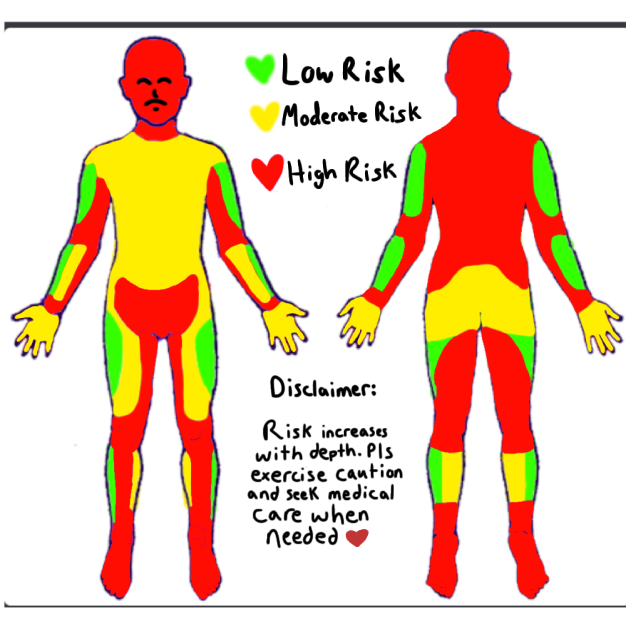Newt's Safety and Care Guide

- Risk increases with depth, which means hypos may be okay in green and epis okay in red, but not vice versa.
- Don't use toilet paper or paper towels to clean your sh! Instead, we recommend gauze or clean, lint-free fabric such as cotton (no animal fibers like wool tho)
- Antibacterial ointment/spray can be used on epis and styros, but avoid putting anything in hypos or deeper, including water and vaseline; instead, use a damp, clean rag to pat clean. Once the wound has scabbed, then you're okay to use ointment and etc.
☆
Identifying & Caring for various sh depths:
Epis/epidermis/cat scratches - these wounds are superficial and shallow, and they look like their namesake, cat scratches.
Care is minimal and may include rinsing the wounds and applying bandaids, but typically they're okay to leave uncovered. Healing time ranges from a few days to a week or so. Scars will be extremely faint and will fade quickly, if they scar at all.
Styros/dermis - these wounds get their name from their white, styrofoam-like appearance. If your sh turns white before it turns red, you've hit styro.
Care may include rinsing, applying antibacterial ointment, and bandaging, but these wounds are also typically fine to leave uncovered. Watch for signs of infection! These wounds will likely scar, although the severity varies by depth. Scars will usually be dark at first and fade to white or skin-colored within 3-6 months. We recommend moisturizing with vaseline or unscented lotion after a scab forms to reduce scarring.
☆☆
Hypos/fat - these wounds are deep and usually result in gaping, and can be identified by large chunks of yellowish adipose (fat) cells underneath the styro layer. Deeper hypo wounds may appear to have two layers, but both are hypodermis. Watch closely for infection at this depth.
Care may include sutures, butterfly closures, and bandaging. Scarring at this level is typically severe, and will likely start out dark and slowly fade to white or skin-colored. The time it takes for scars to fade differs from person to person, but they may take years to fade completely.
Fascia and deeper - these wounds will first appear as a thin, white, fibrous membrane. If you continue past that, you will hit muscle, which is red and slightly firm to the touch. These wounds will likely require medical assistance and may permanently impact your mobility.
If you absolutely must take care of it yourself, care is basically the same as hypos. Scarring at this level is extremely severe and may take several years to fade.
☆☆
Aftercare:
Epis & styros - gently rinse with unscented soap and water, pat dry with a clean, lint-free cloth such as a cotton towel or t-shirt. After a scab has formed, you may moisturize with ointment or unscented lotion to speed healing and reduce scarring.
Hypos & deeper - pat clean with a damp (wring that bitch out) rag, then pat dry with clean, lint-free cloth or gauze. After a scab forms over the entire wound, you may gently rinse with unscented soap and pat dry; at this point you may use ointment or vaseline for "wet healing" to reduce scarring and speed up the healing process.
☆☆
How to recognize infection:
⚠️ Disclaimer! Some of these signs are normal to experience during the healing process and may not be an indicator for infection. These signs will be marked with "[sign]°"⚠️- warm skin around the wound°
- yellow or green discharge coming from the wound
- the wound giving off an unpleasant odor°
- red streaks on the skin around the wound°
- fever and chills
- aches and pains
- nausea and vomiting
If you experience pus, fever, aches & pains, or nausea & vomiting in combination with normal signs of healing, you likely have an infection.
☆☆
Gently clean infected epis and styros with unscented soap and water, make sure there's no fibers or hair or anything stuck in the wound, apply antibacterial ointment/spray, cover with gauze or bandaids, and check it frequently. Repeat until the infection goes away
☆☆
For hypos and deeper the care is a little more complicated bc you can't put anything in the wound. In those cases, you should take antibacterials orally and clean & monitor the wound frequently. Infections at these depths may worsen if they're covered for too long (infection breeds in dark, moist environments), so we recommend giving wounds at least an hour per day to breathe, preferably more. We strongly advise you to seek medical attention for infections at these depths, as they can become life threatening if left untreated.
☆☆
You shouldn't use vaseline if you have other options (like bacitracin or neosporin) because it can clog up your pores, which slows the healing process and can increase risk of infection. Not a huge deal, but something to keep in mind
☆☆
Additional Disclaimer: all of this info has been read and verified by my mom, who is a CNA. This info was collected from extensive research that I've done in combination with advice from members of the server who have experience dealing with certain depths. I do not claim to be a medical professional, nor do I suggest using this guide alone. I encourage everyone to seek a second opinion from a real medical professional if possible.
Stay safe ily all <3